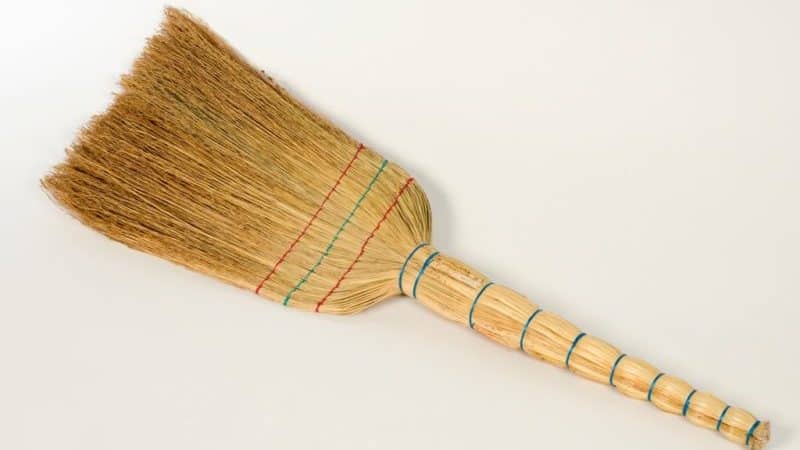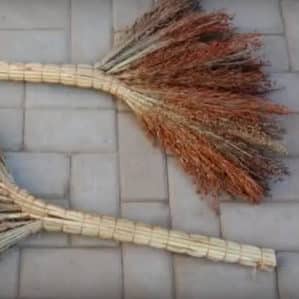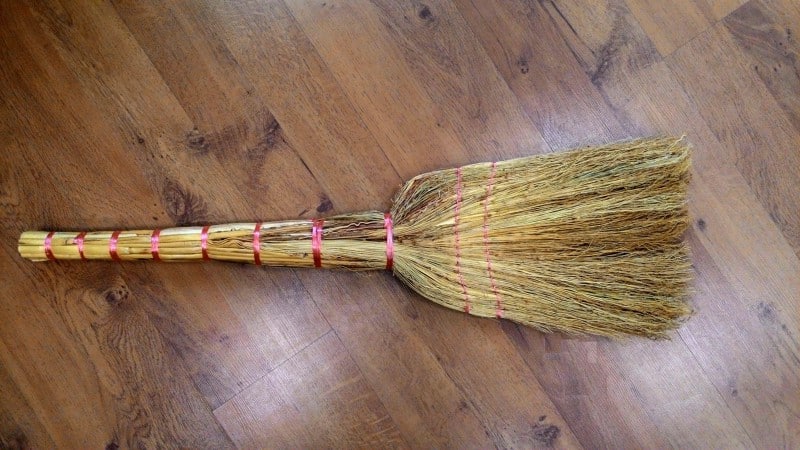Why sorghum broom is so good and how to make it yourself
Manufacturers of household appliances offer a variety of ultra-modern devices for cleaning the premises. However, many housewives still have a cleaning assistant, popular back in Soviet times - a sorghum broom. This simple item began to be produced after the Great Patriotic War, and it quickly spread throughout the country, gradually displacing brooms made from birch twigs, brooms made from aspen and alder, which were previously used for sweeping. We will tell you in detail about the sorghum broom: what it is for, what it is made of and how it is made, how to store and use it.
What is sorghum broom
This golden or reddish-yellow household item is a bunch of dry branches. sorghum plants. In several places the product is stitched with thread, wicker or wire, which gives it a durable blade shape.
What is it needed for
The item is intended for household needs, primarily for sweeping the floor indoors. It has thin rods and a long, durable handle, making it convenient for cleaning in hard-to-reach places: under furniture, in corners, narrow and tight openings, at heights.
In some situations, a sorghum broom outperforms its high-tech competitor, the vacuum cleaner. For example:
- if necessary, clean uneven surfaces;
- in the yard, on the street;
- in the presence of dirty and wet debris;
- when glass is broken or plastic is crushed.
They are convenient for brushing off dust and sweeping out medium and large debris that will get stuck in the vacuum cleaner and clog it. A broom or sorghum broom is usually used to treat surfaces before wet cleaning. It is often used when cleaning carpets and rugs with snow. Some housewives moisten a clean broom in water and spray flowers or linen with it, humidifying the air in the room.

Why is it so popular and why is it good?
The sorghum broom combines a number of qualities that allow it to be indispensable in everyday life for many decades:
- flexibility;
- density;
- elasticity;
- rigidity;
- strength;
- ease;
- ergonomics;
- environmental friendliness;
- naturalness;
- affordability;
- ease of use.
Features of growing broom sorghum

To make brooms, a special cultivated species of the cereal plant sorghum is used, namely technical, or broom, sorghum. This plant is heat-loving, but unpretentious and resistant to long-term droughts, which is not surprising, since it comes from equatorial Africa. The technical variety of sorghum grows with several tall stems more than 2 m long and has a powerful root system that feeds the plant even with minimal moisture. Upon reaching biological maturity, the stems and leaves dry out and become covered with wax.
Planting sorghum is possible in different soils, cleared of weeds: chernozem, loamy, light sandy with mineral fertilizer. Only cold, swampy and acidic lands are not suitable for cultivation.
Attention! Proven varieties of technical sorghum: Tavriyskoe 1, Venichnoe Rannye, Donskoe 35, Kinelskoe 67, Vavigen 100.
Before planting, the seeds are soaked in water for 20-30 minutes, and any pop-up “dummies” are removed.The plant is planted no earlier than mid-May - it does not tolerate even light frosts and is very light-loving. The seeds are sown in a continuous row to a depth of 4-5 cm, keeping a distance of 30 cm between the rows. After the first shoots appear, the beds are thinned out. Next time the soil is loosened after 10 days.
The growing season of the crop is 80-110 days. The yield of the most popular varieties is high - up to 4 c/ha. Sorghum is harvested in September, once a year. The stems are cut by hand using a sickle or disc trimmer.
How to make a broom
The industrial production of sorghum brooms is regulated by the technical document OST 56-31-91.
Before you begin assembling the broom, ripe healthy sorghum stems are dried in a dry, ventilated area for 10 days. After this, the stems are cleared of leaves and seeds with a special comb, sorted by length and thickness and tied into small bunches (rays).
To make a floor broom, take at least three bunches of sorghum with a diameter of 25-30 mm each at the dressing site. The panicle is stitched with uniform ties at least twice using cotton, nylon threads or twine, pulling it together into a strong fan. The handle is tightly tied with a vine or twine at least three times at the same distance from each other. The end of the handle is trimmed evenly and smoothed, the lower part of the panicle is leveled. It is important to achieve a smooth handle surface without scratching protrusions. Finished copies are sent from production for sale.
Making sorghum brooms is always manual or partially automated labor. There is no comprehensive conveyor production of this equipment yet.
Types of products

Sorghum brooms come in the following types:
- brooms for floors;
- brooms;
- brooms for cleaning clothes;
- sorghum panicles.
Depending on the method of fastening the working surface, there are:
- brooms with a pierced whisk;
- brooms with a tied whisk.
They are also divided by the number of panicle piercings. The most common:
- double-stitched;
- three-stitched;
- six-pierced.
Is it possible to make a sorghum broom with your own hands?
The technology for making sorghum brooms is primitive and does not require large financial investments or complex equipment. If you managed to grow raw materials at your summer cottage, it is quite possible to make such a broom at home yourself.
Required materials and tools:
- sorghum panicles - at the rate of 250–350 g of raw materials per 1 broom;
- rope or twine about 2 m long;
- nylon or synthetic thread;
- wooden block 60x5x5 cm;
- wooden slats 40x5x3 cm - 2 pcs.;
- a small piece of rubber (can be cut from an old car tire);
- coupling bolts – 2 pcs.;
- pruning shears or sharp knife;
- scissors;
- shoe awl;
- drill;
- bucket.
Step-by-step instruction:
- Sorghum stems collected in the fall are cleared of leaves and hung from the ceiling to dry for 10-30 days, and if possible, left until spring.
- Dry panicles are cleared of seeds. The simplest device for this is a galvanized bucket. The branch is clamped between the edge of the bucket and the handle and pulled several times so that the grains roll into the container. Dried grain is readily eaten by poultry, including parrots, as well as livestock.
- The sorghum stems are laid out on a flat surface and leveled with pruning shears to the same length of 70-80 cm.
- The rope is firmly tied at one end to the ceiling rail, and a wooden block is attached to the opposite edge, forming something like a pedal.
- The assembled bunch of sorghum is wrapped several times with a rope in the place where the working surface is supposed to be separated from the handle of the future broom, that is, 25-30 centimeters from the heads of the stems.
- To tie the bundle tightly, press the wooden block with your foot until it stops. At the constriction site, a nylon or synthetic thread is passed through the middle of the bundle, and then wrapped around it several times and tied tightly. The ends of the thread are cut and placed inside the broom.
- In the same way, several more constrictions are made along the bunch of sorghum panicles, thereby forming the handle of the future broom.
- Sew the working surface of the panicles. To do this, two wooden slats are whipped at the end with a piece of rubber - the design resembles linen tongs. It acts as a broom lock when flashing. They fasten it with two bolts that go into the drilled holes at the other end of the slats.
- Having carefully laid out the sorghum branches in the form of a fan, it is stitched, retreating 5-10 cm from the base of the handle, pulling the thread through the panicles with a shoe awl. The stitches should be strong, not too sparse, and of the same length. The more firmware, the stronger the product will be.
- The finished broom is leveled with pruning shears or scissors along the edge of the working surface.
Where to buy ready-made and how much does it cost?

The ability to make sorghum broom yourself may only be needed by residents of remote villages who live on subsistence farming and practice barter exchange, or simply out of interest. Citizens purchase this equipment at a hardware store, supermarket, or order it online.
The cost of a simple sorghum broom varies from 50 to 150 rubles. depending on the type of raw materials and the quality of the firmware. Sorghum panicles with long wooden handles are more expensive - up to 1,500 rubles.
Interior designers are happy to use natural materials, including sorghum, to create their objects. Therefore, on sale you can find real works of broom art made from selected sorghum of the highest quality on carved handles made of precious wood.
This is interesting:
What is Sudanese grass, how is it grown and where is it used.
Features of buckwheat digestion: how long it takes to digest.
The best folk remedies for treating cucumbers against diseases.
Rules of application
The average service life of a sorghum broom is from 1 to 2 years. After this period, with frequent use, the stems begin to fluff, bend and fall out. However, if you use the broom carefully, without putting too much pressure on the handle when sweeping, this household tool will last much longer.
Important! To avoid raising a cloud of dust in the room, start the cleaning process with a slightly damp broom from ceilings and cabinets, gradually moving from top to bottom.
To make it easier to process hard-to-reach places, the working surface of the broom is slightly trimmed at an acute angle.
Care
The broom is periodically cleaned with a saline solution (2 tablespoons of salt per 8 liters of boiling water), immersing it in the hot mixture for several hours. After this, the equipment is dried under load. Thanks to this procedure, sorghum panicles are cleaned of accumulated dirt and become elastic and elastic again.
The sorghum broom cannot be stored in a vertical position on a work surface: the sweeping part will quickly deform and become unusable. The ideal option is horizontal storage on a specially designated shelf in a dry place.
Conclusion
Despite the widespread use of vacuum cleaners in the second half of the twentieth century, sorghum brooms are still popular in everyday life. Therefore, this item of inventory should always be at hand. If desired, you can grow raw materials in the garden and make a broom yourself.